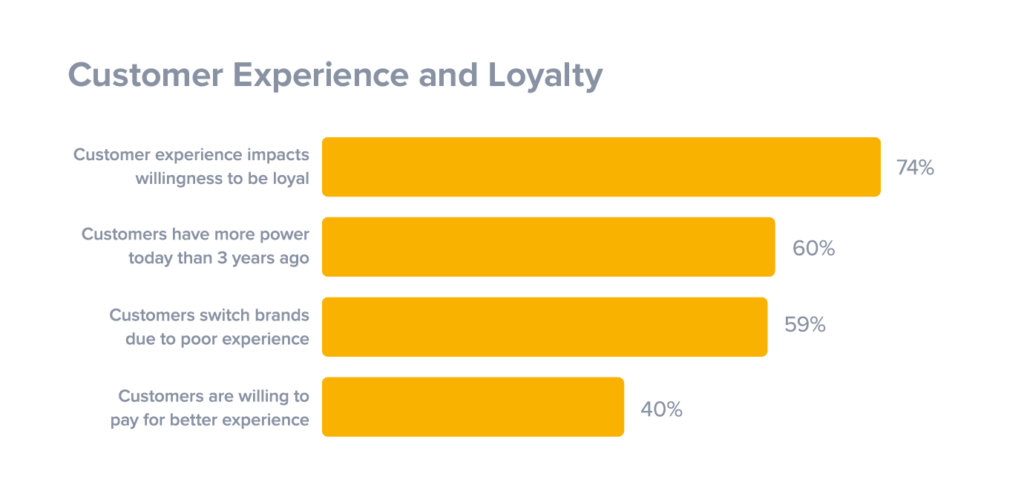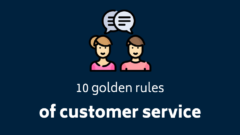Customer experience (CX) is the new buzzword in eCommerce. Good CX strategy allows online businesses to gain loyalty and trust of clients. Here’s how!
In today’s competitive online market peoples expectations about online retail are set quite high. After all, if one online store disappoints them, there are tens or hundreds of other websites where they can leave their money. That’s why you, as a store owner, need to compete for customers’ attention and loyalty. Other online stores already do!
Econsultancy conducted a survey among companies to pinpoint which business opportunity for the year ahead excites them most – and customer experience won.
Shopping in an online store is a self-service. Direct interaction with a customer only occurs if there’s some kind of issue. Due to the lack of face-to-face contact, there’s little opportunity to let the customer feel noticed, acknowledged and cared for. To make up for this anonymous and impersonal approach, turn your online store into a well-oiled, functional machine that is fun to interact with.
If you still doubt the importance of Customer Experience, see the statistics and think again.
Here’s how Customer Experience impacts loyalty:

The underlying assumption of improving customer experience:
Buying from you should be maximally hassle-free. Turn the usual stress associated with spending money into pleasant anticipation and peace of mind.
What should you improve then? The answer is probably – everything. But don’t worry. Perfection is unattainable. We have yet to see an ideal eCommerce business that never failed to satisfy all the customers. But brooding over inevitable shortcomings of your service will get you nowhere. Focus on improving a few details that have the biggest impact on the overall shopping experience.
Here are 3 elements of the customer experience that matter most.
1. Brand Experience
Brand experience is all about developing a long-lasting relationship with a client. People feel safer when dealing with a business they know and trust. Make your store familiar to your target audience by commencing a thought-through branding strategy
Visual identity
Coherence is the key when it comes to building a recognizable brand. Read our guidelines on how to plan a visual identity for an online store.
Touchpoints
When a potential client first hears about your company, he or she begins a journey that should eventually lead them to the after-checkout thank you page. Repeatedly. This journey is composed of many encounters with your logo, ads, social media, reviews, website, and hopefully – real life recommendation from friends. Plan every touchpoint carefully, so that it conveys the core values of your brand as well as the important information about your product.
Design
The UX and CX are tightly interlinked. Nothing projects the feeling of dependability better than a well-designed website that works as it should. There’s no place for reinventing the wheel when it comes to building a website – use the common patterns that are familiar to shoppers. Read this guide prepared by UXpin to learn more about consistency in UI and UX design.
2. Smooth Checkout
Pay close attention to the checkout process in your store. Why? Because of two facts:
- checkout is the most stressful part of the whole buying experience. Smooth it out to avoid cart abandonment problem.
- after all, this is the moment when you are getting paid for your hard work – don’t make it harder than it should be.
Now, let’s dig into the details.
Implement guest checkout
You can’t trick a customer into being loyal. But still, many online retailers try to inspire commitment by forcing clients to register. It doesn’t work. According to SaleCycle’s survey, 23% of customers have not finished their purchase because they had to create an account. Allow those who are in a hurry to get what they want – a quick buy, without pointless retardations. Gather only the data that are essential to receive money and send out the order.
Still, registration is beneficial both for you and your clients. Offer the possibility to register after the purchase – it’s a much more elegant and less imposing solution.
Make password recovery easy
If your client already created an account, then don’t make him do it again when he or she forgets the password. Especially, that having two accounts registered on the same email address might prove problematic, and your eCommerce software probably won’t allow that. It’s bad for everyone – the client gets nothing but a dose of frustration, and you lose sales you didn’t even know you could have.
Gather feedback
Every eCommerce checkout needs a different kind of upgrades. Observe closely how your clients interact with your website and let them show you where there is room for improvement. Make a short feedback form available for anyone who’d wish to share their experience.
See how Crate&Barrel do it:

3. Problem recovery
The third important element of customer experience is the way that your store handles issues.
Respond to reviews
Public review services like Trustpilot.com or Reviews.io can list your business without letting you know about it. However, you can easily claim your company’s profile and start responding to reviews. And you’re highly recommended to do so! Service both good and bad reviews – respond to accusations, explain the reasons behind delays and thank for kind words from satisfied clients. Don’t forget to monitor your social media and address any issues that clients describe there.
Improve customer service
CX and customer service are not the same thing. The term “customer experience” encompasses every interaction between client and business, whereas customer service is only about direct support and
Wrap-up
Customer Experience is a continuum of touchpoints that, if planned carefully, build a favourable, trustworthy image of your company and brand.
It’s impossible to build a flawless CX strategy overnight, so start small. Pick the areas where your business can improve most, prioritise them, and slowly work your way to the less critical issues. Don’t forget to gather customers feedback on every stage to see the effects of your efforts.
About the author

- Elliot
- Content specialist and gaming enthusiast. Trained to be a philosopher. Interested in Deep Learning, scalability and startups.






